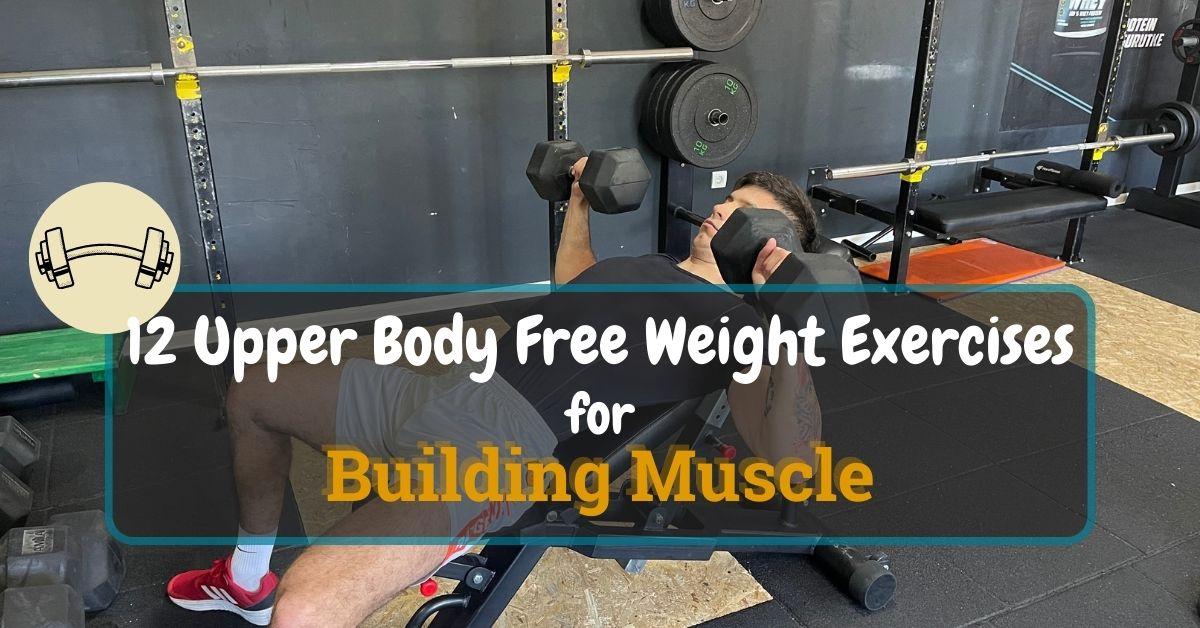Incorporating upper body free weight exercises into your workout regime is the best way to improve your functional strength and upper body mobility.
Table of Contents
ToggleUnlike machines, free weight exercises will allow for a greater range of motion, require your stabilizers to activate, and increase your overall proprioception due to more stimuli being received through receptors.
As a Faculty of Sport and Physical Education student, it took me 25 hours to research, test, and evaluate 40 upper body free weight exercises and only single out those that would yield the best results regarding functionality, hypertrophy, and strength.
After reading the article, you will learn the 13 best upper body free weight exercises, how to perform every one of them, how to warm up for such a workout, and what training principles you must follow to achieve the best results.
Start Building Your Dream Body Today
Ready to elevate your fitness game without falling into the trap of dull, repetitive routines that just don’t deliver? Imagine sculpting your ideal physique and boosting your health, all while still enjoying life’s pleasures, like those irresistible weekend getaways and your aunt’s legendary cheesecake. With our online fitness and nutrition coaching service, you don’t have to compromise. Dive into a personalized fitness journey that blends perfectly with your lifestyle, not against it. Book your completely free discovery consultation today, and take the first step towards a transformation that doesn’t require giving up the joys of life.

“I was skeptical about online fitness coaching, but Functional Body Savage completely changed my perspective. Vanja and Radomir’s personalized approach and attention to detail have helped me achieve goals I never thought possible. I’m stronger, more confident, and grateful for their guidance.”
Emily Thompson, San Francisco, CA
Learn More About Our Online Coaching ServiceQuick Summary
- The best upper body free weight exercises include barbell bench press, dumbbell shoulder press, bent-over rows, incline dumbbell chest press, dumbbell front raises, dumbbell lateral raises, dumbbell reverse flyes, dumbbell overhead triceps extension, and many more.
- To warm up for the upper-body free weight workout, you must raise your body’s temperature, perform a dynamic warm-up, and activate muscles that will be prime movers during the training.
- The training principles you must follow to get the most from an upper-body free weight workout include progressive overload, hypertrophy training principles, and recovery periods.
Upper Body Free Weight Exercises
- Barbell Bench Press
- Dumbbell Shoulder Press
- Bent-Over Rows
- Incline Dumbbell Chest Press
- Dumbbell Front Raises
- Dumbbell Lateral Raises
- Dumbbell Reverse Flyes
- Dumbbell Overhead Triceps Extension
- Dumbbell Curls
- Dumbbell Chest Fly
- Dumbbell Pullover
- Kettlebell Farmer’s Walk
1. Barbell Bench Press
The barbell bench press is a classic chest exercise that targets the pecs, triceps, and front deltoids.
You can target different parts of your chest by varying the angle of the bench or the grip width.
How to Perform a Barbell Bench Press
- Position yourself on a flat bench, with your feet planted firmly on the ground and your back flat against the bench.
- Grasp the barbell with palms facing forward, hands wider than shoulder-width. Your grip should be such that your forearms are vertical when the bar is at your chest.
- Lift the barbell off the rack (or have a spotter help you) and hold it straight over your chest with extended arms.
- Inhale and slowly lower the barbell to your chest, keeping your elbows at about a 75-degree angle from your body.
- Once the barbell touches your chest, push it back up to the starting position while exhaling.
- Your arms should be fully extended, and the barbell should be directly above your chest.
- Ensure your back, especially the lower back, stays in contact with the bench during the movement.
- Repeat for the desired number of reps.
2. Dumbbell Shoulder Press
The dumbbell shoulder press is one of the best dumbbell exercises for overall shoulder development.
The dumbbells overhead press can help improve both your stability and mobility.
How to Perform a Dumbbell Shoulder Press
- Stand or sit with a dumbbell in each hand at shoulder height, palms facing forward. Ensure your feet are planted firmly on the ground, about hip-width apart.
- Engage your core and keep your back straight. Your elbows should be bent at about 90 degrees.
- Press the dumbbells upward, fully extending your arms without locking your elbows. During the movement, the dumbbells should remain above the level of your head.
- Hold the position momentarily before slowly lowering the dumbbells back to the starting position. Ensure you maintain control of the movement throughout.
- Repeat for the desired number of reps to maintain the form and not let your back arch.
3. Bent-Over Rows
Bent-over rows are a versatile exercise that targets the muscles in your back, enhancing strength and muscular endurance.
This exercise can help improve both your pulling strength and your posture.
If you want to learn how to perform dumbbell bent-over rows, read our comprehensive guide to master the technique and maximize performance.
How to Perform Bent-Over Rows
- Stand upright and hold a barbell with an overhand grip, hands wider than shoulder-width apart.
- Bend your knees slightly and hinge forward from the waist, keeping your back flat and nearly parallel to the floor.
- Hold the barbell directly below your chest, with arms fully extended.
- Pull the barbell towards your lower chest by bending your elbows and squeezing your shoulder blades together.
- Hold the contracted position briefly, then slowly lower the barbell back to the starting position with arms fully extended.
- Keep your core tight throughout the whole exercise.
- Repeat for the desired reps, maintaining your posture throughout the movement.
4. Incline Dumbbell Chest Press
The incline dumbbell chest press focuses on the upper part of the pectoralis major, helping to build the upper chest.
This exercise also works the triceps and the front deltoids, making it an excellent inclusion for your upper body workout routine.
For more advanced lifters, incorporating a landmine single-arm press can also be beneficial for chest, deltoid, and triceps development.
How to Perform an Incline Dumbbell Chest Press
- Set your bench to an incline angle of 15 to 30 degrees.
- Sit on the bench with a dumbbell in each hand at shoulder level, palms facing away from you.
- Press the dumbbells until your arms are fully extended, ensuring you don’t lock out your elbows at the top.
- Lower the weights slowly in a controlled motion back to the starting position, maintaining alignment with your shoulders.
- Repeat for the desired reps, maintaining the form throughout the movement.
5. Dumbbell Front Raises
Dumbbell front raises mainly target the anterior deltoids and upper chest muscles.
They’re great for improving shoulder flexibility and range of motion.
The exercise also requires engagement from your core muscles to stabilize your body.
How to Perform Dumbbell Front Raises
- Stand straight with a dumbbell in each hand, palms facing towards your body, and dumbbells resting on your thighs.
- Keeping your torso stationary, lift the left dumbbell in front of you with a slight bend in the elbow. Raise the weight until your arm is slightly parallel to the floor.
- Lower the dumbbell back down in a controlled motion to the starting position.
- Repeat the same movement with the right dumbbell.
- Alternate between arms for the desired number of reps, maintaining your posture throughout the movement.
6. Dumbbell Lateral Raises
Dumbbell lateral raises are an effective exercise for targeting the lateral deltoids.
They’re excellent for building broader shoulders and creating a well-rounded upper body appearance.
Moreover, incorporating exercises like incline Y raises can further complement this development, focusing on the upper back and shoulder region for a more comprehensive upper body workout.
How to Perform Dumbbell Lateral Raises
- Stand upright with a dumbbell in each hand, palms facing your body, and arms straight down at your sides.
- Keeping a slight bend in your elbows, lift the dumbbells to your sides until your arms are parallel with the ground.
- Pause briefly at the top of the movement before slowly lowering the dumbbells to your sides.
- Repeat for the desired reps, ensuring you maintain control throughout the movement.
7. Dumbbell Reverse Flyes
The dumbbell reverse flyes primarily targets the upper back muscles, specifically the posterior deltoids, rhomboids, and the middle and lower trapezius.
This exercise is beneficial for improving posture and shoulder stability.
How to Perform Dumbbell Reverse Flyes
- Hold a dumbbell in each hand and stand with your feet shoulder-width apart.
- Bend your knees slightly and lean forward from your hips while keeping your back flat. The dumbbells should hang down from your shoulders with your palms facing each other.
- Raise your arms out to your sides, keeping a slight bend in your elbows until they’re parallel with the floor. Squeeze your shoulder blades together at the top of the movement.
- Slowly lower the dumbbells back to the starting position in a controlled motion.
- Repeat for the desired number of reps, ensuring proper form throughout.
8. Dumbbell Overhead Triceps Extension
The overhead triceps extension targets the triceps, which are crucial muscles for any pressing movements or activities that require pushing.
Strengthening the triceps can also help with elbow joint stability. If you want to isolate your triceps further but still exercise with a bigger load, try the dumbbell tricep press variation.
How to Perform an Overhead Triceps Extension
- Stand or sit with a dumbbell in one hand, working arm fully extended above your head. This will be your starting position.
- Keeping your upper arms close to your head and stationary, lower the dumbbell behind your head until your forearms touch your biceps. The only part of your arms that should move is your forearms.
- Use your triceps to return the dumbbell to the starting position by extending your arms.
- Repeat for the desired reps, maintaining proper form and control throughout.
9. Dumbbell Curls
Dumbbell curls are a great isolation exercise for the biceps and the brachioradialis, a forearm muscle.
The bicep curl will help you improve both the size and strength of these muscles.
How to perform dumbbell curls
- Stand up straight with a dumbbell in each hand, arms fully extended, and palms facing forward.
- Keeping the upper arms stationary, curl the weights while contracting your biceps as you breathe out. Only the forearms should move.
- Continue the movement until the dumbbells are at shoulder level and your biceps are fully contracted.
- Slowly bring the dumbbells back to the starting position as you breathe in.
- Repeat for the desired number of reps, maintaining proper form and control throughout.
10. Dumbbell Chest Fly
The dumbbell chest fly is a great exercise for isolating the chest muscles, especially the pectoralis major.
It helps enhance chest size and strength while involving the anterior deltoids to a lesser extent.
How to Perform Dumbbell Chest Flyes
- Lie on a flat bench with a dumbbell in each hand, palms facing each other.
- Extend your arms above your chest, but slightly bend at your elbows to prevent strain.
- With a controlled motion, lower your arms at both sides in a wide arc until you feel a stretch in your chest. Your arms should remain stationary, moving solely from the shoulder joint.
- Return your arms to the starting position as you squeeze your chest muscles.
- Repeat for the desired number of reps, ensuring control throughout the movement.
11. Dumbbell Pullover
The dumbbell pullover is a unique exercise as it works both the chest and the back, particularly the latissimus dorsi and pectoralis major.
This makes it a versatile addition to any workout routine.
How to Perform a Dumbbell Pullover
- Lie perpendicular to a flat bench with only your shoulders resting on it. Your feet should be flat on the floor and your body parallel to the ground.
- Hold a dumbbell with both hands directly over your chest, keeping your arms fully extended.
- While keeping your arms extended, lower the weight slowly in an arc behind your head.
- Pause once you feel a full stretch in your chest and lats, then lift the weight back over your chest in the same slow, controlled arc.
- Repeat for the desired number of reps, ensuring to keep your movements controlled and deliberate.
12. Kettlebell Farmer’s Walk
The kettlebell farmer’s walk is a functional exercise that mimics real-world movements.
It’s excellent for building grip strength, core stability, and overall endurance while working for various muscle groups.
How to Perform Kettlebell Farmer’s Walk
- Stand tall and pick up a kettlebell in each hand, keeping your arms by your sides.
- Keeping your shoulders down and back, walk forward at a steady pace.
- Continue for a set distance or time, keeping your back straight and your head up throughout the exercise.
Related Articles:
How to Warm-up for Upper Body Free Weight Exercises?
To warm up for upper body free weight exercises, you must raise your body’s temperature, perform a dynamic warm-up, and activate muscles that will be prime movers during the training.
To raise your body’s temperature, hop on the treadmill and run for 3-4 minutes. This will be enough to raise your temperature and increase your muscle flexibility and freedom of movement at the level of joints.
For a dynamic warm-up, you want to choose exercises biomechanically similar to the main movements and exercises you will perform during the upper body workout. Think about internal and external shoulder rotations, banded rows and overhead presses, and upper body bodyweight exercises.
To activate your prime movers, you want to perform exercises from the list above with 30% and 50% of your 1RM for up to 5 reps and then transition to the maximum load you lift that day. This will be enough to warm-up and prepare your entire upper body for the workout.
What Training Principles Should I Follow for an Upper Body Free Weight Workout?
The training principles you should follow for an upper body free weight workout are progressive overload, hypertrophy training principles, and recovery time.
Below you can find a brief explanation for each of these terms.
Progressive Overload
Progressive overload is a fundamental principle in strength training that involves consistently increasing the musculoskeletal system’s demands to continually gain muscle size, strength, and endurance.
Simply put, to get stronger and build muscle, you must constantly make your muscles work harder than they’re used to.
This can be achieved in several ways.
The most common method is by increasing the weight lifted.
However, progressive overload can also be accomplished by:
- Increasing the volume of work done (more sets or reps)
- Increasing the frequency of workouts
- Decreasing rest time between sets to increase the intensity
- Introducing more complex exercises to challenge the body’s capabilities
Importantly, the principle of progressive overload should be implemented gradually.
Sudden and excessive increases can lead to injury and overtraining. It’s often a game of balance – pushing just hard enough for improvement but not so much that it leads to burnout or injury.
Proper nutrition and rest are also key in allowing the body to recover and adapt to the increased demands.
Hypertrophy Training Principles
Hypertrophy training focuses on increasing muscle size.
The main principles include the following:
- Volume: Higher training volume (sets x reps x load) is essential for muscle hypertrophy. Aim for 3-6 sets of 6-12 reps per exercise.
- Intensity: Use weights 60-80% of your one-rep max (1RM) – heavy enough to challenge you but light enough to maintain proper form.
- Progressive Overload: Continuously increase the stress placed on the muscle over time, either by increasing the weight, reps, or total sets or decreasing rest time between sets.
- Frequency: Train each muscle group at least twice weekly for optimal muscle stimulation and growth.
- Recovery: Adequate rest and nutrition are vital for muscle repair and growth. Aim for 48-72 hours of rest between sessions targeting the same muscle group, and maintain a protein-rich diet.
- Mind-Muscle Connection: Focus on the muscle you’re working, contract it fully during each rep, and control your movements to maximize muscle engagement and growth.
Recovery Time
Resting between 48-72 hours between two workout sessions targeting the same muscle groups is recommended.
However, for smaller muscle groups such as calves or biceps, the smaller rest periods, such as 12 or 24 hours, apply,
On the contrary, when you perform squats and hit almost all the major muscle groups, you must rest for 72 hours or more.
This is also highly individual, morphology, and metabolism-dependent.
Related Articles:
What Are the Best Free Weight Chest Exercises?
The best free weight chest exercises are bench press, incline bench press, and decline bench press.
These bench press variations will yield the most significant amount of strength and are the best free weight chest exercises for increasing overall muscle hypertrophy.
In addition, free weight chest exercises such as dumbbell chest press, dumbbell chest flyes, and close grip bench press are also excellent for developing your pectoral muscles.
What Are the Best Free Weight Back Exercises?
The best free weight back exercises are bent-over rows.
This free weight back exercise will effectively target your biggest back muscles, such as the latissimus dorsi, trapezius, and rhomboids.
In addition, reverse flyes and shrugs are also excellent for developing your overall back strength and hypertrophy.
What Are the Best Free Weight Arm Exercises?
The best free weight arm exercises are dumbbell bicep curls and overhead tricep extensions.
These free weight arm exercises will efficiently build your biceps brachii, brachialis, brachioradialis, and all three tricep heads, including lateral, medial, and long.
You may also perform variations of these exercises, such as rope curls, t-bar curls, bar curls, rope tricep extensions, and skull crushers.
What Are the Best Free Weight Shoulder Exercises?
The best free weight shoulder exercises are the barbell overhead press, dumbbell overhead press, and lateral raises.
These free weight shoulder exercises will build shoulder strength and muscle hypertrophy, lowering the chance of rotator injuries and improving your joint’s stability.
You may also perform variations of these exercises with kettlebells to further increase your functionality and strength.
What Are the Best Free Weight Lat Exercises?
The best free weight lat exercises are single-arm dumbbell rows, bent-over rows, and renegade rows.
These free weight lat exercises will effectively exercise the biggest back muscle, the latissimus dorsi, and allow you to build sufficient muscle hypertrophy and strength.
You may also perform incline rows, dumbbell pullovers, and pendlay rows to exercise your lats.
FAQs
Can You Build Upper Body With Just Dumbbell Exercises?
Yes, you can build your upper body with just dumbbell exercises. The upper body dumbbell workout is excellent for increasing your overall stabilizer strength and functionality and increasing muscle mass.
How Do I Exercise My Upper Body?
You exercise your upper body by performing exercises according to 4 movement patterns. These include vertical push, vertical pull, horizontal push, and horizontal pull patterns, and you should choose exercises according to those functional movements.
How Do I Tone My Upper Body Only?
You tone your upper body only by performing different upper body exercises. However, performing an upper body exercise only without ever exercising your core or lower body muscles is bad, and you will build muscle imbalances.
How Do You Train a Weak Upper Body?
You train a weak upper body by first starting with upper body bodyweight exercises. You can build a solid strength base with bodyweight exercises before transitioning to more complex free weight training.
How Can I Build Upper Body Strength?
You can build upper body strength by exercising your upper body muscles and following a progressive overload principle. This means increasing the overall intensity, workout volume, sets, or reps for each following workout to ensure maximum progress.
How Many Exercises Should I Do on Upper Body Day?
The amount of exercises you should do on upper body day will depend on your current fitness level, age, gender, and many other factors.
A good place to start is to choose at least three exercises if you are following the push/pull philosophy since you can build a significant amount of strength and hypertrophy with that approach.
However, the more advanced you get, the more exercises you can fit into a workout and perform with greater intensity.
Let me know in the comments below your favorite upper body free weight exercises.
Start Building Your Dream Body Today
Ready to elevate your fitness game without falling into the trap of dull, repetitive routines that just don’t deliver? Imagine sculpting your ideal physique and boosting your health, all while still enjoying life’s pleasures, like those irresistible weekend getaways and your aunt’s legendary cheesecake. With our online fitness and nutrition coaching service, you don’t have to compromise. Dive into a personalized fitness journey that blends perfectly with your lifestyle, not against it. Book your completely free discovery consultation today, and take the first step towards a transformation that doesn’t require giving up the joys of life.

“I was skeptical about online fitness coaching, but Functional Body Savage completely changed my perspective. Vanja and Radomir’s personalized approach and attention to detail have helped me achieve goals I never thought possible. I’m stronger, more confident, and grateful for their guidance.”
Emily Thompson, San Francisco, CA
Learn More About Our Online Coaching Service




